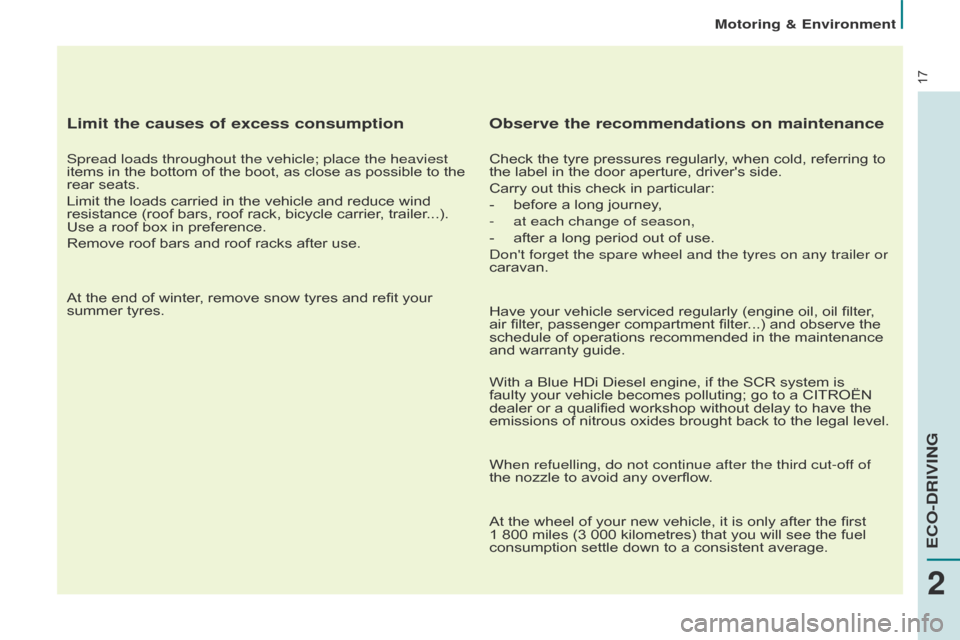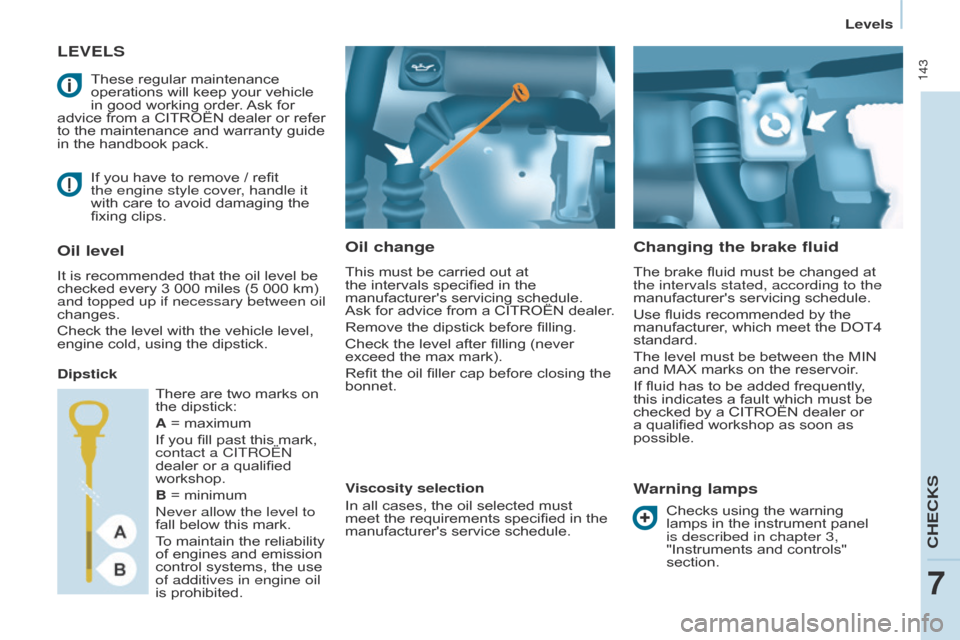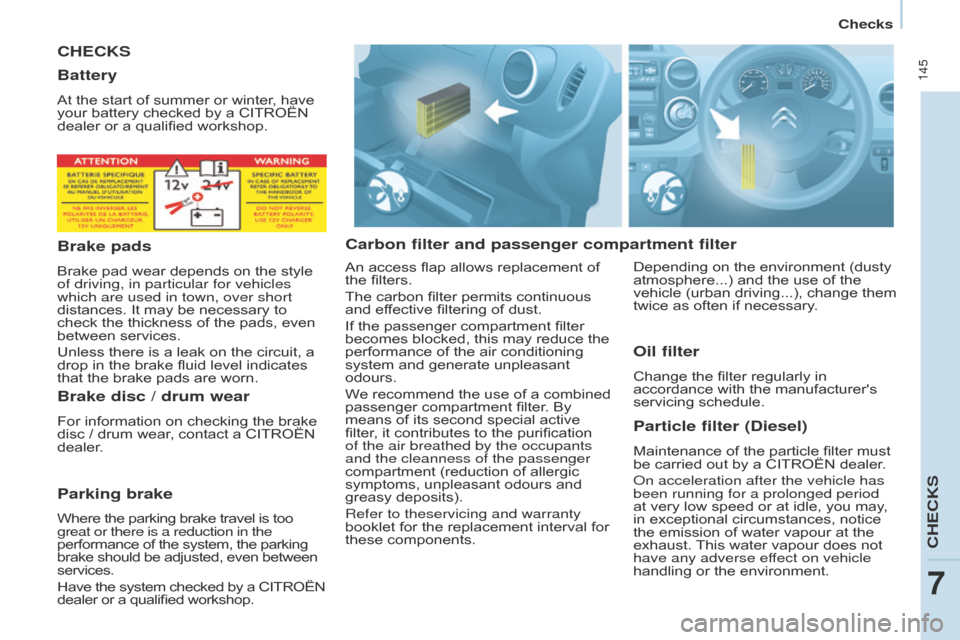service schedule Citroen BERLINGO MULTISPACE RHD 2014.5 2.G Owner's Manual
[x] Cancel search | Manufacturer: CITROEN, Model Year: 2014.5, Model line: BERLINGO MULTISPACE RHD, Model: Citroen BERLINGO MULTISPACE RHD 2014.5 2.GPages: 276, PDF Size: 12.15 MB
Page 19 of 276

17
Limit the causes of excess consumption
Spread loads throughout the vehicle; place the heaviest
items in the bottom of the boot, as close as possible to the
rear
seats.
Limit
the loads carried in the vehicle and reduce wind
resistance
(roof bars, roof rack, bicycle carrier, trailer...).
Use
a roof box in preference.
Remove
roof bars and roof racks after use.
At
the end of winter, remove snow tyres and refit your
summer
tyres.
Observe the recommendations on maintenance
Check the tyre pressures regularly, when cold, referring to the label in the door aperture, driver's side.
Carry
out this check in particular:
-
before
a long journey,
-
at each change of season,
-
after
a long period out of use.
d
on't forget the spare wheel and the tyres on any trailer or
caravan.
Have
your vehicle serviced regularly (engine oil, oil filter,
air
filter, passenger compartment filter...) and observe the
schedule
of operations recommended in the maintenance
and
warranty guide.
With
a Blue HDi Diesel engine, if the SCR system is
faulty
your vehicle becomes polluting; go to a CITROËN
dealer
or a qualified workshop without delay to have the
emissions
of nitrous oxides brought back to the legal level.
When refuelling, do not continue after the third cut-off of
the
nozzle to avoid any overflow.
At
the wheel of your new vehicle, it is only after the first
1
800 miles (3 000 kilometres) that you will see the fuel
consumption
settle down to a consistent average.
2
EcO-drIVInG
Motoring & Environment
Page 145 of 276

Berlingo_2_VP_en_Chap07_Verification_ed02-2014
143
LEVELSOil change
This must be carried out at the intervals specified in the
manufacturer's
servicing schedule.
Ask
for
advice
from
a
CITROËN
dealer
.
Remove
the dipstick before filling.
Check
the level after filling (never
exceed
the max mark).
Refit
the oil filler cap before closing the
bonnet.
changing the brake fluid
The brake fluid must be changed at the intervals stated, according to the
manufacturer's servicing schedule.
Use
fluids recommended by the
manufacturer
, which meet the DOT4
standard.
The
level must be between the MIN
and
MAX marks on the reservoir.
If
fluid has to be added frequently,
this
indicates a fault which must be
checked
by a CITROËN dealer or
a
qualified workshop as soon as
possible.
Warning lamps
If you have to remove / refit
the engine style cover , handle it
with
care to avoid damaging the
fixing
clips.
Oil level
It is recommended that the oil level be checked every 3 000 miles (5 000 km)
and topped up if necessary between oil
changes.
Check
the level with the vehicle level,
engine
cold, using the dipstick.
d
ipstick
Viscosity selection
In
all cases, the oil selected must
meet
the requirements specified in the
manufacturer's
service schedule.
These
regular maintenance
operations
will keep your vehicle
in
good working order.
Ask
for
advice
from a CITROËN dealer or refer
to
the maintenance and warranty guide
in
the handbook pack.
Checks using the warning
lamps
in the instrument panel
is described in chapter 3,
"Instruments
and controls"
section.
There
are two marks on
the
dipstick:
A
= maximum
If
you fill past this mark,
contact a CITR
o Ë n
dealer
or a qualified
workshop.
B
= minimum
n
ever allow the level to
fall
below this mark.
To
maintain the reliability
of
engines and emission
control
systems, the use
of additives in engine oil
is
prohibited.
Levels
CHECkS
7
Page 147 of 276

Berlingo_2_VP_en_Chap07_Verification_ed02-2014
145
cHEcKS
c
arbon filter and passenger compartment filterParticle filter (
d iesel)
Maintenance of the particle filter must be carried out by a CITROËN dealer.
o
n acceleration after the vehicle has
been running for a prolonged period
at
very low speed or at idle, you may,
in
exceptional circumstances, notice
the
emission of water vapour at the
exhaust.
This
water vapour does not
have any adverse ef
fect on vehicle
handling
or the environment.
Battery
At the start of summer or winter, have your battery checked by a CITROËN
dealer
or a qualified workshop.
Brake pads
Brake pad wear depends on the style of driving, in particular for vehicles
which are used in town, over short
distances.
It may be necessary to
check
the thickness of the pads, even
between
services.
Unless
there is a leak on the circuit, a
drop
in the brake fluid level indicates
that
the brake pads are worn.
Brake disc / drum wear
For information on checking the brake disc / drum wear, contact a CITROËN
dealer
.
Parking brake
Where the parking brake travel is too great or there is a reduction in the
performance
of the system, the parking
brake
should be adjusted, even between
services.
Have
the system checked by a CITROËN
dealer
or a qualified workshop.
Oil filter
Change the filter regularly in accordance with the manufacturer's
servicing
schedule.
An
access
flap
allows
replacement
of
the
filters.
The
carbon
filter
permits
continuous
and
effective
filtering
of
dust.
If
the
passenger
compartment
filter
becomes
blocked,
this
may
reduce
the
performance
of
the
air
conditioning
system
and
generate
unpleasant
odours.
W
e
recommend
the
use
of
a
combined
passenger
compartment
filter.
By
means
of
its
second
special
active
filter
,
it
contributes
to
the
purification
of the air breathed by the occupants
and the cleanness of the passenger
compartment
(reduction
of
allergic
symptoms,
unpleasant
odours
and
greasy
deposits).
Refer to theservicing and warranty
booklet
for
the
replacement
interval
for
these
components. Depending
on the environment (dusty
atmosphere...)
and the use of the
vehicle
(urban driving...), change them
twice
as often if necessary.
Checks
CHECkS
7
Page 151 of 276

Berlingo_2_VP_en_Chap07_Verification_ed02-2014
149
AdBLuE® AddItIVE
A
nd S
cr
SYS t EM
FO
r B
L
u
E H dI dIESEL
E
n
GI
n
ES
To assure respect for the environment and conformity with the new Euro 6
emissions
standard, without adversely
af
fecting the performance or fuel
consumption
of Diesel engines,
CITROËN
has taken the decision to
equip
its vehicles with an effective
system
that associates SCR (Selective
Catalytic Reduction) with a particle
filter
(FAP) for the treatment of exhaust
gases.
Presentation of the Scr system
Using an additive called adBlue®
containing urea, a catalytic converter
turns up to 85% of nitrous oxides
(
no
x) into nitrogen and water, which
are
harmless
to
health
and
the
environment.
The
a
dBlue
® additive is held in a
special
tank
located under the boot
at
the
rear
of the vehicle. It has a
capacity
of
17 litres: this provides a
driving
range of about 12 500 miles
(20
000 km), after which an alert
is triggered warning you when the
reserve
remaining is enough for just
1
500
miles
(2 400 km).
d
uring each scheduled service of
your vehicle by a CITR
o Ë n dealer
or
a
qualified workshop, the
AdBlue®
additive
tank
is
refilled
in
order
to
allow
normal
operation
of
the
SCR
system.
If
the
estimated
mileage
between
two services is greater than
12 500 miles
(20
000
km),
we
recommend
that
you
go
to
a
CITROËN
dealer
or
a
qualified
workshop
to
have
the
necessary
top-up
carried
out.
o
nce the a dBlue
® tank is empty, a
system
required by regulations
prevents
starting
of the engine.
If the SCR
is faulty, the level of
emissions
from
your
vehicle will no
longer
meet
the
Euro
6 standard: you
vehicle
becomes
polluting.
In
the
event
of
a
confirmed fault
with
the
SCR
system,
you must go
to
a
CITROËN
dealer
or a qualified
workshop
as
soon
as
possible: after
a
running
distance
of
650 miles
(1
100
km),
a
system
will be triggered
automatically
to
prevent engine
starting.
AdBlue® additive
cHEcKS
7